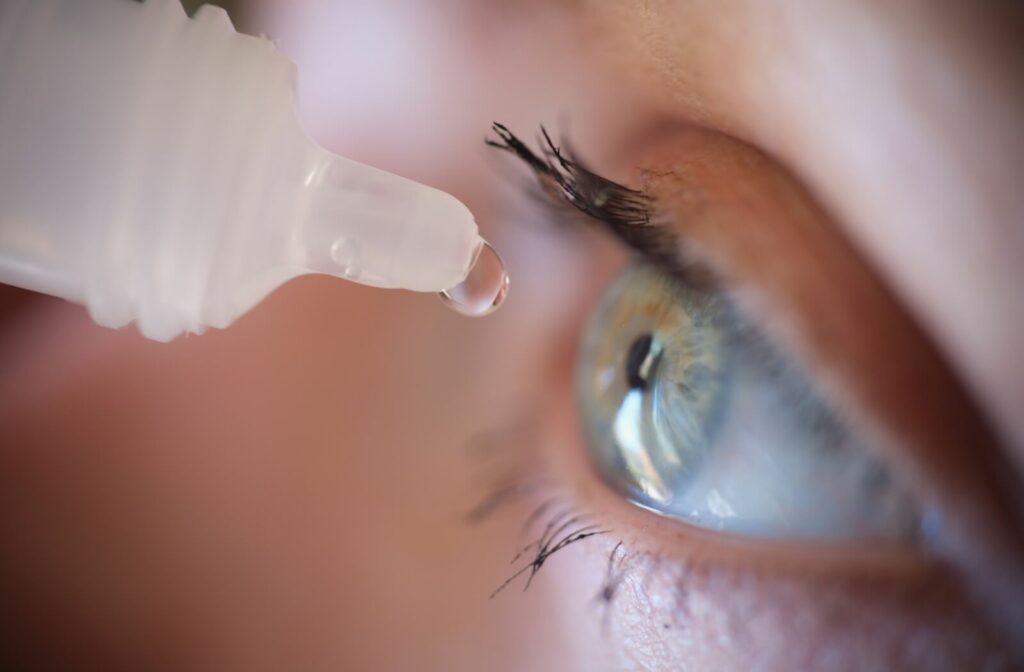If you’ve ever experienced dry, irritated eyes, you may have also noticed your vision becoming blurry. While many people associate dry eye syndrome with discomfort, this condition can also significantly impact how clearly you see. However, can dry eyes actually cause blurriness? The short answer is yes—dry eyes can make your vision intermittently or consistently blurry.
If you experience stinging, burning, redness, or a gritty sensation in your eyes, you may have dry eye disease (DED). Understanding the connection between dry eyes and blurred vision—and knowing what professional treatments are available—can help you restore comfort and improve your sight.
What Is Dry Eye & Dry Eye Disease?
Dry eye occurs when your meibomian glands do not produce or release enough good quality tears to keep the surface of the eye hydrated and protected. Tears play a crucial role in eye health by lubricating, washing away dirt and debris and providing essential nutrients to maintain clear vision.
Dry eye disease (DED) develops when there is a persistent issue with tear production or tear composition. If your eyes don’t produce enough tears—or if your tears evaporate too quickly due to an imbalance in their oil, water, or mucus layers—this can lead to chronic dryness, irritation, and blurry vision.
Types of Dry Eye Disease
There are two main types of dry eye disease:
- Aqueous Deficient Dry Eye (ADDE) – The eyes do not produce enough tears, often due to aging, medical conditions, or certain medications.
- Evaporative Dry Eye – The eyes produce tears, but those tears evaporate too quickly, often due to meibomian gland dysfunction (MGD), environmental factors, or excessive screen time.
As tear quality directly impacts vision clarity, dry eye disease can cause intermittent or persistent blurriness. Left untreated, it may lead to inflammation, corneal damage, and difficulty performing everyday tasks like reading or driving.
The good news? Effective in-office treatments and modern therapies are available to restore moisture, improve tear stability, and protect long-term eye health.
How Does Dry Eye Disease Lead to Blurry Vision?
Tears play a vital role in maintaining clear vision. They form a smooth, even layer over the eye’s surface, allowing light to pass through without distortion. When the tear film is disrupted due to poor tear production or excessive evaporation, this causes irregularities in how light is refracted, leading to blurriness.
Common Symptoms of Dry Eye Disease
Along with blurred vision, dry eye disease may also cause:
- Burning or stinging sensations
- Redness and irritation
- A gritty or foreign body sensation
- Excessive watering (reflex tearing due to dryness)
- Sensitivity to light
- Difficulty wearing contact lenses
Symptoms can vary from mild irritation to severe discomfort. If left untreated, dry eye may lead to long-term damage to the cornea.
Understanding Tear Film & Meibomian Gland Dysfunction (MGD)
Your tear film consists of three layers:
- Oil (lipid) layer – Prevents tear evaporation
- Water (aqueous) layer – Hydrates the eye
- Mucus layer – Helps tears spread evenly across the surface and holds lipid layer on the surface
If the meibomian glands (the oil-producing glands in the eyelids) become clogged or inflamed, this can lead to meibomian gland dysfunction (MGD), one of the leading causes of dry eye disease. When the oily layer of the tear film is insufficient, tears evaporate too quickly, resulting in evaporative dry eye disease and blurred vision.
What Causes Dry Eye Disease?
Decreased Tear Production
Some people do not produce enough tears to keep their eyes hydrated. This is known as aqueous tear-deficient dry eye and can result from:
- Aging
- Medical conditions (e.g., autoimmune diseases)
- Certain medications (e.g., antihistamines, antidepressants)
- Diminishing of corneal nerve sensitivity
Increased Tear Evaporation
Other people experience evaporative dry eye, where inadequacies in the oily layer of their tears cause their tears to evaporate too quickly. This can be caused by:
- Meibomian gland dysfunction (MGD)
- Reduced blinking (often from excessive screen time)
- Eyelid problems (such as blepharitis)
- Environmental factors (wind, smoke, dry air)
- Vitamin A deficiency
In-Office Dry Eye Treatments for Lasting Relief
If dry eyes are causing persistent blurred vision and discomfort, professional treatment can help restore clarity and long-term relief. Modern optometry clinics and certified ocular hygienists offer a range of in-office therapies designed to target the root cause of dry eye disease.
ZEST (Zocular Eyelid System Treatment)
ZEST is a gentle, in-office eyelid exfoliation treatment designed to remove dead cells, debris, and biofilm that accumulate along the eyelid margins. This treatment uses an okra-infused gel containing citrus extract, aloe vera, and caffeine to restore eyelid health and reduce inflammation, burning, and irritation. During a ZEST appointment, you can expect the following:
- A warm compress is applied to relax the eyes and loosen clogged meibomian glands.
- The ZEST formula is applied to exfoliate and cleanse the eyelids.
- The treatment refreshes and restores the natural state of your eyelids, promoting healthier tear production.
LUCENT IPL (Intense Pulsed Light Therapy)
LUCENT IPL™ is an advanced light-based treatment that targets ocular inflammation and meibomian gland dysfunction (MGD). IPL technology has been used for decades in dermatology and is now recognized as an effective dry eye therapy. Benefits of LUCENT IPL include:
- No pain or downtime
- Fast results
- No eye drops or medication required
- Long-lasting improvement in tear quality
IPL helps to reduce inflammation, stimulate oil production, and restore normal tear film stability.
LipiFlow & LipiScan
LipiFlow is a meibomian gland expression therapy that uses heat to remove blockages from the glands responsible for producing the oil layer of your tears. This in-office procedure combines gentle heat and massage to restore the natural flow of oils into your tear film.
LipiScan is used as part of the dry eye assessment to provide high-definition images of the meibomian glands. Together, LipiFlow and LipiScan help diagnose and treat MGD, preventing further tear evaporation.
Radiofrequency (RF) Therapy
Radiofrequency therapy uses controlled energy waves to heat the inner layers of the skin, stimulating collagen production and melting blockages in the meibomian glands. Radiofrequency helps dry eyes by:
- Increasing oil flow in the tear film
- Reducing inflammation around the eyes
- Improves overall eyelid health
This comfortable, non-invasive treatment enhances tear stability and provides lasting dry eye relief.
Low-Level Light Therapy (LLLT)
LLLT uses near-infrared light to gently warm the eyelids and stimulate oil production in the meibomian glands. Unlike artificial tears, LLLT targets the root cause of dry eye, improving natural lubrication and reducing tear evaporation. The following people can often benefit from LLLT:
- Patients with chronic MGD
- Individuals who experience severe dry eye symptoms
- Those looking for a drug-free, non-invasive treatment option

Other Dry Eye Management Options
In addition to in-office treatments, we can also offer dry eye therapies, including:
- Tear breakup analysis – Non-invasive imaging to assess tear stability and determine the best treatment approach.
- Drop therapy – Artificial tears, prescription, or Plasma Rich in Growth Factors (PRGF) drops tailored to the severity of your condition.
- Eyelid hygiene therapy – Eyelid scrubs, warm compresses, and masks to cleanse and restore proper lubrication.
- Omega-3 supplements – Dietary adjustments and supplements to improve the eye’s oil film and prevent tear evaporation.
- Specialty contact lenses – hard contact lenses to prevent tear evaporation, creating clear and comfortable vision
Say Goodbye to Dry Eye at Niagara Vision
Living with dry eye disease can be frustrating, especially when it affects your vision and daily comfort. But you don’t have to settle for constant irritation or blurry sight. With the right care, you can restore moisture, improve tear stability, and protect your long-term eye health.
At Niagara Vision in Niagara Falls, ON, we take a personalized approach to dry eye treatment and therapies, offering effective solutions like ZEST, IPL, LipiFlow, RF therapy, and LLLT. Our certified ocular hygienists specialize in diagnosing and treating dry eye disease, helping you find lasting relief tailored to your needs.
If dry eye symptoms are interfering with your quality of life, we’re here to help. Take our dry eye questionnaire and book an appointment today and take the first step toward clearer, more comfortable vision.








